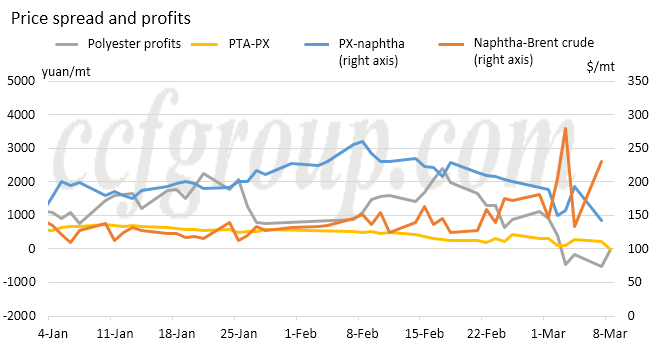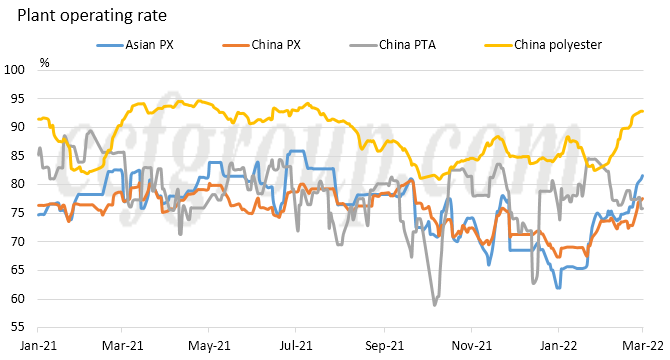Polyester chain O/R maintains high despite poor economics
Since the Russia-Ukraine conflict in end-Feb, petrochemicals have been driven up by the spikes in crude oil. However, with price gains in petrochemicals lagging behind that in raw material, the profits for most products have been squeezed rapidly. PX-naphtha spread narrowed to $142/mt on Mar 7, new low since end-Dec 2021; and PTA-PX spread was crunched to -12yuan/mt, hitting record low. The composite profits of polyester (including POY, FDY, PSF and PET bottle chip) has also fallen to negative territory, worst since end-Sep 2021. In addition, MEG also suffers from losses.

Therefore, market participants are very concerned about any production cuts due to the poor economics. However, as of the time of this writing, the plant operating rates have been maintaining at regular level and the operating rates of some products even show an uptrend. Though PTA plant operating rate has dropped since end-Jan in China, it is still at relative medium and slight high level given the current economic situation. As for PX and polyester, the operating rates even tick up lately, in contrast to some’s expectation. Some participants may see it quite confusing why producers are not cutting production given the poor economics.

Though some polyester plants have announced maintenance plans on Mar 8, the scale of capacity scheduled for maintenance seems to be small compared to the losses producers are suffering, and large polyester plants have not announced maintenance.
The reasons for the current high operating rates in spite of poor economics
1. Plants reserved low-priced feedstock earlier

During the production, producers usually have reserves of feedstock and use feedstock prepared days earlier. Product prices are rising rapidly recently, while the current production cost based on feedstock average price in last 10 or 15 days is relatively low, therefore, high cost pressure gets relieved. In addition, the value in product inventory due to weak sales after the holiday, also increases with price rising.
2. Participants are cautious about price rise with persistent geopolitical conflict
Some participants start to accept high crude oil price. Though some believe there could be oil price slump after the spikes, it is difficult to forecast when oil price would pull back, and with the complicated international situation, crude oil price may further move up, which is to say, crude oil market is unlikely to fall in the short term. Therefore, as the value in product inventory may further increase, producers keep stable production pace. However, if there’s any adverse signal from the market, producers would respond accordingly.
3. Competitiveness of integrated plants strengthens
With the development of integration of industry chain in recent years, the leading companies have mostly achieved integration from upstream to downstream sectors. As of end-2021, about 76% of PX capacity have downstream PTA and polyester plants, 87% PTA capacity have polyester plants and 65% polyester capacity have downstream integration in China. It augments the competitiveness of the companies by reducing the production cost, but also weakens the flexibility of the companies.
4. Contract
Nowadays, contracts take the largest proportion in the selling and supplying of crude oil, naphtha, PX as well as PTA. Therefore, in addition to consideration of the production and profits, companies also need to maintain good customer relation and keep the product influence.
It has only lasted for 2 weeks since the outbreak of Russia-Ukraine conflict. Any production cut is complicated issue which needs comprehensive consideration, and it is difficult to implement in the short term. In addition, some plants have already completed maintenance during China’s spring festival holiday in early Feb.
If the losses continues, producers would cut production or shut plants, but it takes time.
- Top keywords
- Cotton Price
- Cotton Futures Price
- Cotton Futures
- CZCE
- PTA Futures Price
- Chemical Fiber
- Polyester Prices
- Wool price
- PTA Futures
- Shengze Silk
- China
- Yarn Price
- price
- China Textile City
- Fibre Price
- Benzene Price
- Cotton
- Index
- Cotton Index
- PTA
- fabric price
- NYMEX
- Top 10
- textile industry
- Spot Cotton
- Cotton Yarn
- Polyester Price
- Futures
- PTA Price
- cotton yarn price

